NOVID Provides COVID-19 Early Warning System
The COVID-19 pandemic has turned us all into amateur statisticians. How many tests are being performed? What’s the local infection rate? Is the rate of hospitalizations going up or down? What percentage of cases are severe or fatal?
We voraciously consume these numbers in an attempt to quantify the answer to this question: What is my risk of infection? Of course, there are plenty of follow-up concerns about the likelihood of a severe case, how that would affect our lives, what risk we would pose to others, and so on, but it all starts with the risk of infection.
At first blush, it might seem that the Apple/Google exposure notification technology might help in this regard (see “Apple and Google Partner for Privacy-Preserving COVID-19 Contact Tracing and Notification,” 10 April 2020). But no, it can’t help you assess your individual risk. It notifies you only if you were in the vicinity of someone who later reports a positive COVID-19 test. By definition, that information travels more slowly than the virus—you learn about an infection only after it’s too late to do anything differently. Not receiving a notification isn’t helpful, either. It could mean that people with whom you came into contact weren’t infected, didn’t know they were infected, chose not to report a positive test, hadn’t enabled exposure notifications, or weren’t carrying a smartphone.
Plus, although many of us would like to know if we had been exposed so we could quarantine to protect others, there are lots of people who actively don’t want to know because they can’t afford to quarantine. Even though the Apple/Google technology is a triumph on the privacy front, its benefits accrue primarily to society at large, not to the individual enabling it. Noble, yes, but less compelling than a direct selfish appeal.
NOVID Early Warning System
NOVID, a new app developed by Carnegie Mellon University mathematician Po-Shen Loh (who also coaches the highly competitive US Math Olympiad team), focuses on the benefit to the individual in its take on anonymously tracking contacts through mobile phone proximity. What if, instead of stopping at one level of separation—your direct contacts—like the Apple/Google technology does, the app kept making additional connections, so you could learn if friends of friends were infected, and the friends of their friends, and so on? Would you change your behavior if you could see that infections were close to you or far away?
That’s what NOVID enables—it applies the “six degrees of separation” concept to infection awareness. (Keep in mind that “friends” here means “people running the NOVID app who have come into contact with one another”—there’s no requirement that you actually know anyone in the network.) In fact, NOVID goes further, tracking your personal contact network out to 12 degrees of separation.
When someone in that broad network reports a positive COVID-19 test, NOVID can alert you if you’re one degree of separation away, just like the Apple/Google technology. More interesting is how that information can be used to describe the state of the overall network. Since the number of people at every level of the network grows exponentially, the number of infections at each level of the network will grow as well. Perhaps there are more than ten infections among your 12th- and 11th-degree connections, seven in the 10th level, four in the 9th level, two in the 8th and 7th, one in the 6th, and none in the 5th through 1st. The graph might look like this.
Thus, NOVID shows you how close the infections in your network are to you. The fact that there are no infections until you get to six degrees of separation suggests that it’s unlikely that you would be exposed under your current behavior. However, if infections started to pop up in your 3rd- or 4th-degree connections, you might want to take additional precautions. In essence, NOVID is an early warning system for COVID-19 infections.
It’s worth taking a few moments to think about how that might play out at low and high levels of community infection. If your area has a low level of infection, the utility of NOVID’s early warning system to most people is to confirm that they don’t need to worry much. However, if you are only a degree or two away from the handful of cases that do exist, you’d probably want to take significant precautions. In a high level of community infection, NOVID could either confirm that extra precautions were necessary or let you know that your particular network is relatively unaffected.
Proximity and Privacy
Technically, NOVID works a bit differently than the Apple/Google technology, which relies solely on Bluetooth. Instead, NOVID combines data from Wi-Fi, Bluetooth, and—optionally—ultrasound. Wi-Fi is useful only for determining general connections, so NOVID won’t generate exposure notification warnings should a contact detected only through Wi-Fi test positive. NOVID primarily relies on Bluetooth proximity to trigger exposure notifications because it’s most readily available. For the highest accuracy, however, NOVID can employ ultrasound to determine proximity within inches, thanks to the fact that sound travels at a constant rate and doesn’t pass through walls or floors well. Alas, NOVID can’t use ultrasound in the background on iOS devices as it can on Android, which renders it less effective for iPhone users.
If ultrasound is enabled, when NOVID detects another phone running NOVID through Bluetooth, both phones exchange a few seconds of high-frequency sounds that are far beyond the range of human speech (18.5–19.5 kHz). For this reason, NOVID requires permission to use the microphone, and it advertises the fact that an independent review by Georgia Tech’s CIPHER Lab confirmed that NOVID does not record, store, or transmit any recordings. And of course, you can just disable it in the settings if you prefer.
NOVID preserves anonymity in roughly the same way the Apple/Google technology does, by collecting only information like randomly generated identifiers, timestamps, distance measurements, and Bluetooth signal strength, along with positive test results. There’s nothing to connect you with any of that data on the backend. The major difference between NOVID and the Apple/Google technology is that NOVID must maintain information about how all the anonymous users are connected to build the full 12-level network.
One final note. In my testing so far, NOVID’s battery usage has been minimal—just a few percent per day—and less than Apple’s own Exposure Notifications entry in the Settings > Battery list.
The Many Informing the One
Beyond being able to see how close infections are, and if they’re moving closer or farther away, NOVID’s network approach can provide a lot more information to help you evaluate what’s happening. For instance, NOVID reports how many other NOVID users you’ve met per day, and if you tap that graph, you can see what proximity detection method was used. Suppose you learn that you met three other users but the connections were merely brief Bluetooth interactions. In that case, that’s more reassuring than learning that one of the interactions was a prolonged ultrasound (close range) interaction. And it becomes easy to discount members of your household with whom you have prolonged Bluetooth or Wi-Fi interactions. You can even get proximity alerts if you want to tell when you’re around other NOVID users.
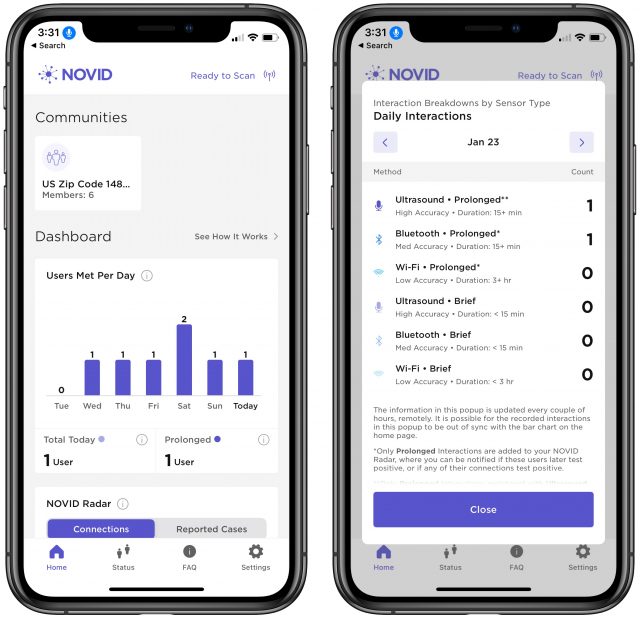
Then there’s the NOVID Radar display, which shows either how many connections you have or the number of reported cases in each of your 12 degrees of connections. (Happily, there’s a See Demo button that shows you what it will look like before you have any connections.)
There’s also a Community Dashboard that provides insights about your area. When you sign up, you can join a “community” associated with the first three digits of your ZIP code. Also, some cities, like Santa Fe, and some institutions, like Georgia Tech, have adopted NOVID and are promoting its use. When you do that, NOVID provides details about how many people are in your community, how many cases there are, details about the average user’s network, the number of exposure notifications sent, and an iOS versus Android breakdown. None of this data is essential, of course, but it’s fun to look at, and it will give you a sense of the NOVID adoption in your community.
The other top-level screens in the NOVID app detail exposures (and let you report a positive test or exposure alert from an official contact tracer), provide an FAQ that explains more about NOVID in detail, and let you adjust a few settings. Most notable among those is the need for Background Mode on the iPhone, which NOVID needs to be able to monitor when the app isn’t open. (That’s an advantage of the Apple/Google technology being built into iOS and Android.) It also features a prominent Share button you can tap to send a canned message that will invite friends to NOVID.
Let’s Build the Network
Obviously, the problem that NOVID faces right now is adoption. It has over 100,000 users, but many people reading this could be the first NOVID users in their communities. That might seem to be an insurmountable obstacle, but as Po-Shen Loh somewhat gleefully explained when I spoke with him, NOVID can spread along the same exponential lines of social connection as the coronavirus.
The app’s Share button text encourages everyone to invite two others. If everyone who downloaded NOVID did that, it would take only 33 generations of invitations before the entire population of the planet had been invited (see the Wheat and Chessboard Problem). Silly, I know. In the real world, many people won’t invite anyone, but perhaps tens of thousands of TidBITS readers can make up for a lot of the dead-end installations. Po-Shen Loh noted that although more is always better, NOVID needs only about a 20% adoption rate in a community for the data to be useful.
So let’s give it a try! If a metric boatload of TidBITS readers install NOVID, and each of us invites at least two other people—even if you just get your family members to install it—maybe we can provide the grassroots effort that’s needed for NOVID to take off.
Getting people accustomed to NOVID might provide a longer-term benefit. Leaving aside the threat of a future pandemic, we don’t yet know if we’ll need to get COVID-19 vaccines annually, like the flu shot. If that proves to be the case, seeing COVID-19 infections on the rise in your extended network could encourage you to get your annual shot sooner rather than later.
In theory, NOVID could also be repurposed to monitor the spread of any infectious disease. Having lost Christmas in 2019 to a bad case of the flu that hammered half of my extended family, I know I would have appreciated knowing that the disease was rampant in Santa Fe. Perhaps then we wouldn’t have visited the amazing—but undoubtedly germ-laden—Meow Wolf immersive art installation (currently closed, of course, but be sure to watch the video). Heck, would you bail on an unnecessary large social gathering—or at least wear a mask—if you knew that the common cold was spiking within your 1st- or 2nd-degree connections?
For now, I’d settle for getting a sense of just how close the 30–50 cases per day in Tompkins County are to me. And finally, if you’re interested in learning more about NOVID from the horse’s mouth, Po-Shen Loh has an explanatory video that’s similar to the conversation he and I had several days earlier.
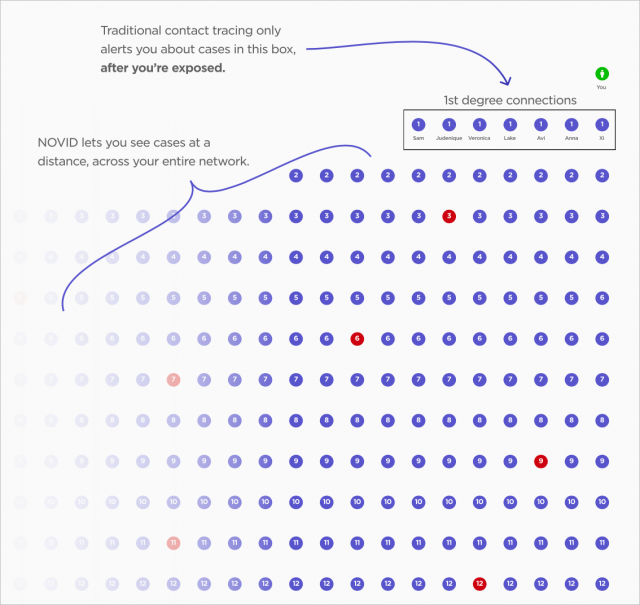
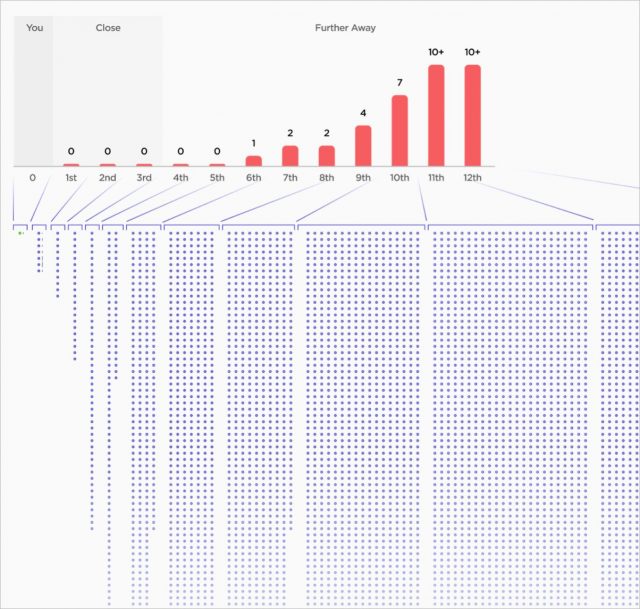
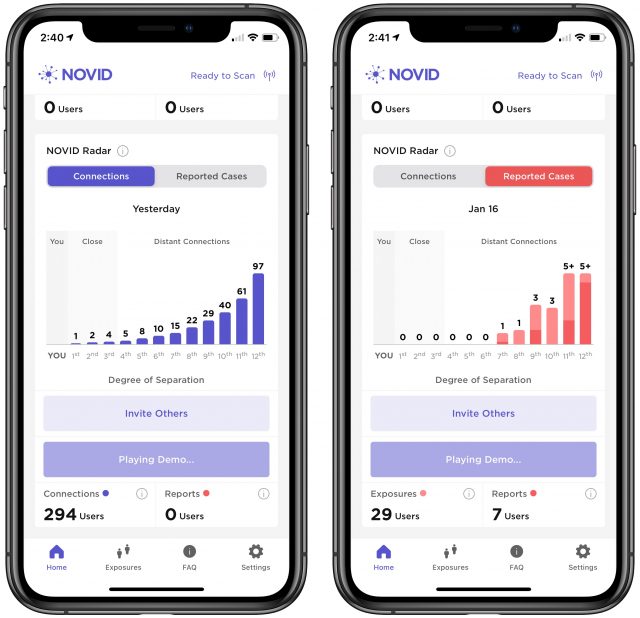
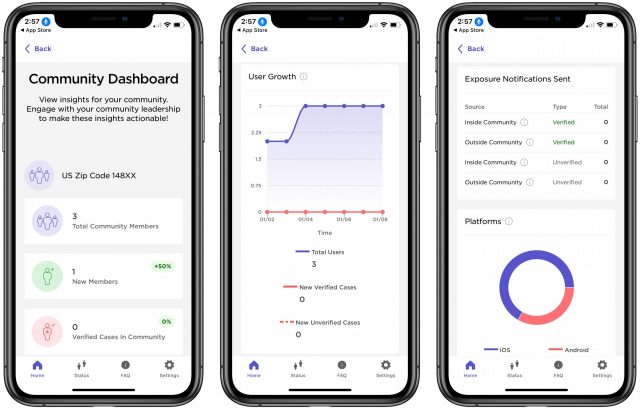
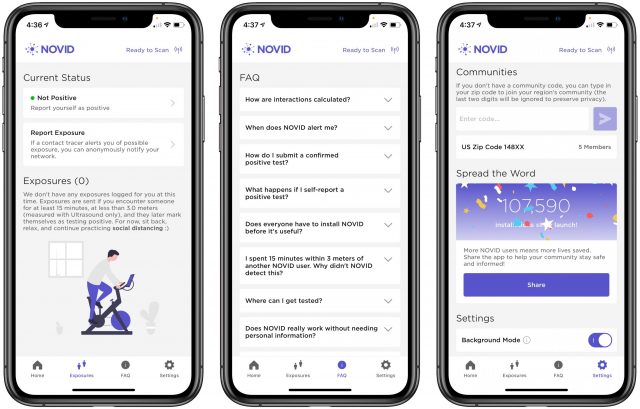
Our state government has mandated that all must register via QR symbols whenever entering a shop, hotel, club house, playing grounds and more. We log on using the government issued QR reader and only our name, mobile (cell) numbers and location are recorded. We only need to enter our name and mobile (cell) details once. The process has become second nature.
If somebody does become positive to the virus, then the government can use its system to do the same as proposed by NOVID and trace everybody who has been in the same place and at the same time as that person testing positive. The system can do the tracing very quickly and thereby reducing the likelihood of further spreading.
There are a few citizens who protest about civil liberties and refuse to use the system, but they get short shrift and we like it when they get fined.
What state is that?
So, now that you’ve all installed NOVID , how many people are in your community, and are you meeting other NOVID users in the wild? It likely won’t happen right away, but I’m encouraging my local friends to install as well to build out my personal early warning system. The other group I’m evangelizing to right now is the local food co-op. It’s a lot of people from around the community all congregating on a single shared space to do their grocery shopping. Plus, it’s a relatively cohesive group compared to the usual grocery store, which wouldn’t have as many ways to communicate with shoppers.
, how many people are in your community, and are you meeting other NOVID users in the wild? It likely won’t happen right away, but I’m encouraging my local friends to install as well to build out my personal early warning system. The other group I’m evangelizing to right now is the local food co-op. It’s a lot of people from around the community all congregating on a single shared space to do their grocery shopping. Plus, it’s a relatively cohesive group compared to the usual grocery store, which wouldn’t have as many ways to communicate with shoppers.
I was a bit disappointed to see that despite being in a college town I was only no. 3 to sign up. A couple days later there’s still only 6 people in my ZIP (my wife being one of them). So far she’s been my only contact (I guess that’s kind of the point of SIP), but at least she’s showing as prolonged.
I heard from several people I tried to get to sign up that they’d join once more people were on it. Um, yeah. Ugh.

Clearly NOVID needs to gamify this a bit more. It’s a little tricky with everything being anonymous, but at least communities could compete to see which had the most uptake. When I first started, my ZIP was at 3, and now it’s up to 9. But if people would just invite two others…
It is the State Government of New South Wales of Australia. Our other states and territories have implemented similar apps as they each have their own health systems and people.
This post might read as if I am paranoid. I am, but my questions are motivated more by curiosity than paranoia, in this case.
The Privacy Policy says the App collects the device’s BSSID and SSID and possibly the first half of the IP address. Where can I find my device’s BSSID and SSID? (A search in Settings did not find these items.) Much of the time, my iPad is not connected to the internet, so I expect it would not have an IP address. What does this mean for my usage?
These are Wi-Fi parameters.
The SSID is the name of the wireless network you’re connected to. The BSSID is the access point’s MAC address.
And NOVID collects these because it does a broad proximity search based on devices that are using the same Wi-Fi network. That’s really imprecise, however, so then it looks via Bluetooth and then ultrasound, if enabled.
Thanks, @Shamino and @ace. No wonder I couldn’t find the information in Settings > General > About.
By “not connected to the internet”, I mean that Cellular Data is off and no Wi-Fi network is selected. In that case, if I understand correctly, I have no SSID, BSSID, or IP address. Would you expect that NOVID would adapt somehow and still be useful? Bluetooth and Wi-Fi are both turned on.
Hmm… First off, NOVID is only really useful on devices that you carry with you when you’re interacting with other people. So for an iPad, it would have to be something you carry with you while you’re out. If that’s true, but you aren’t connected to a Wi-Fi network, Wi-Fi won’t be useful as a proximity-detection method, but Bluetooth (and optionally ultrasound) will be. Wi-Fi isn’t particularly useful for proximity-detection because its range is so large.
At this time, I am not interacting with other people much. Also, at this time, I generally do have the iPad with me. Also also at this time, NOVID says my community has one member, so all this is rather academic.
But my original question was what does NOVID do when it cannot follow the procedures it outlines it its Privacy Policy. In other words, if my iPad doesn’t have an SSID or a BSSID or an IP address, can NOVID ever detect that my iPad is near another device that is running NOVID and report it to my device? Or to the other device?
Yes, as I said, it uses Bluetooth or ultrasound, which are better than Wi-Fi anyway.
I installed it on my iPhone and gave it the Zip code prefixes for Fort Worth and Dallas. So I’m in two “Communities.” There are 2 members in each. Not too useful.
That is not, of course, what NOVID does. NOVID doesn’t actually know who anybody is.
Thanks. I drew the wrong assumption. No point then in installing NOVID.
Thanks for that hint. I hadn’t realized I could enter two ZIP codes. I have now done so. You’re ahead of me, though. In the newly added community, there is one member (presumably me), and in the first community, there are two members (presumably me, since I installed NOVID on a second iOS device).
I reread the Privacy Policy and concluded that I made an unwarranted assumption that NOVID used the SSID and BSSID and IP address to detect proximity. But I’m left wondering what it does do with those items, and what it does if those items are not available.
That’s too bad, but think of it this way. If you encourage your friends to install it and tell them they need to evangelize as well, you could responsible for starting the viral growth locally. :-)
There is a point, which is that it can help you evaluate your personal risk based on the infection closeness in your contact network. It’s about giving you information that you can use to determine your behavior, not help with contact tracing after the fact (the Apple/Google technology does that).
Now, the fact that you’re in Australia, where the infection levels are pretty low, does make it less interesting, I think, since people are probably quite a bit less worried than they are in the US and in other parts of the world.
Oh, I did let my friends know! I posted a link to your Tidbits article on my Facebook page. I also sent email to the Mayor of Fort Worth and asked if the city could perhaps promote use of the app.
It’s really the combination of prevention (social distancing, masks, quarantine, crowd limits, modelling), detection (people testing, sewage testing), rapid response (medical response teams, QR registration, mobile phone tracing, travel passes, credit cards), strong expert messaging, and high degree of community agreement to controls and advice are the reasons for the low infection rates in Australia and in other countries taking similar approaches.
I guess if someone in your contact network gets the virus then NOVID might help alert that fact to others in your contact network and so reduce transmission rates. I cant work out if the data held by NOVID might be also used by medical tracing teams to trace the source and the spread of infection inside and outside your contact network.
The Apple, Google etc COVID-19 apps just didn’t work in Australia - poor design, poor usability, US-centric, etc.
It is heartening to see the new US Administration taking much needed action to reduce the spread of this virus and the deaths caused by this virus in the US.
Yes, the theory is that if you can see that someone only several degrees of separation away has been infected, you should take more precautions. If the nearest infections are far away, there would be no reason to change your behavior.
I don’t think so, because it’s entirely anonymous. I can’t see how contact tracing teams would be able to leverage it in any useful way at the individual level.
I installed the app and identified my community by zip code. I invited twenty contacts and got two signups. So now we have seven listed.
I also sent the developers two suggestions:
" I like the app. Consider adding a flag to identify if a person has received both doses of vaccine so that you can build a herd immunity network diagram."
" Hi, you need to improve your advertising!
Great suggestions, and I’ll pass them on. Their communications are fairly polished professional work, but they don’t seem to do much in the way of marketing. For instance, the NOVID site has a collection of printable signs but they’re all general to COVID-19, and none of them actually promote NOVID with a QR code. And they have a Style Guide, but none of the assets in there work for marketing either.
I’d also like to see the app prompting users to recommend it to another friend every so often—people will do it once but then not think about it again unless nudged. It could be a setting that could be turned off.
I am catching up on TidBITS articles, so I just installed NOVID. Discouraged to see that in my region, which has a population of over 200,000 people, I’m the lone adopter so far. I shared the article on my social networks, and I hope our collective efforts start to snowball.
Yeah, it seems that TidBITS readers are too widespread. I’ve seen the overall number of NOVID users increase by several thousand since that article ran (tap Settings), but it’s not taking off like I’d hoped.
I keep sending in suggestions to their feedback link (my latest):
Interesting article:
The article mentioned an opportunity for you:
Saskia Popescu, an infectious-disease epidemiologist at George Mason University, told me that everyone, vaccinated or not, should try to keep track of three metrics in your area: The number of new daily cases per 100,000 people, the rate at which people transmit the virus to one another, and the rate at which people test positive for the virus. Popescu said that there are no magic numbers that would immediately bring the country back to pre-COVID life, but she’ll feel better about reopening when we hit daily case rates of just one to two per 100,000, transmission rates of .5 or less, and test-positivity rates at or below 2 percent. (As of last week, no U.S. state had reached the trifecta, and the country as a whole is still far from it.) Many local public-health departments regularly provide these numbers.
I believe you could provide these numbers to people in your Novid.app since you already have zip code information and I suspect local health departments use that designation for sorting their Covid data. It may require an API or other approaches to extract data from the individual health departments.
Also, you could include a window with prompts to help people identify what their specific risk choices should be (anybody in your family over age…, anyone with compromised immune system or other underlying conditions, etc.
I really like the idea of the NOVID app providing those area-level stats
Whenever I’m curious about the rate per 100,000, I check the New York Times pages.
Test positivity is a trickier number because it’s dependent on the number of tests performed. Here in Tompkins County, where Cornell makes it possible to test 5000-10000 people per day, our positivity rate is incredibly low—usually around 0.2%. Next door, in Tioga County, where I grew up, they’re lucky if they do 400 tests per day and thus their positivity rate is much higher, about 4% of late.
But in general, yes, I find that one of the reasons I check NY’s COVID Alert NY app every day (other than to record that I’m feeling fine, thank you) is to check the county-level stats. NOVID could probably do better job of that.